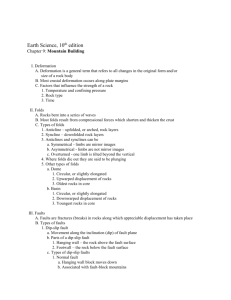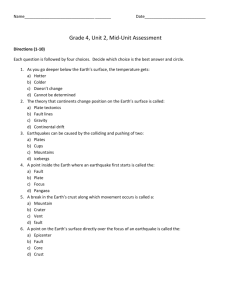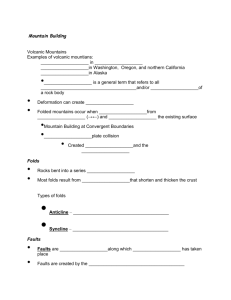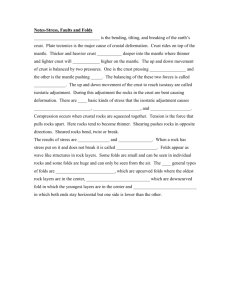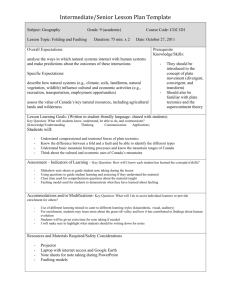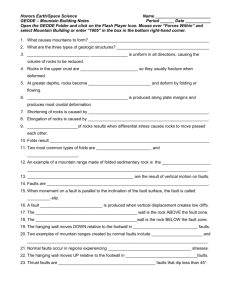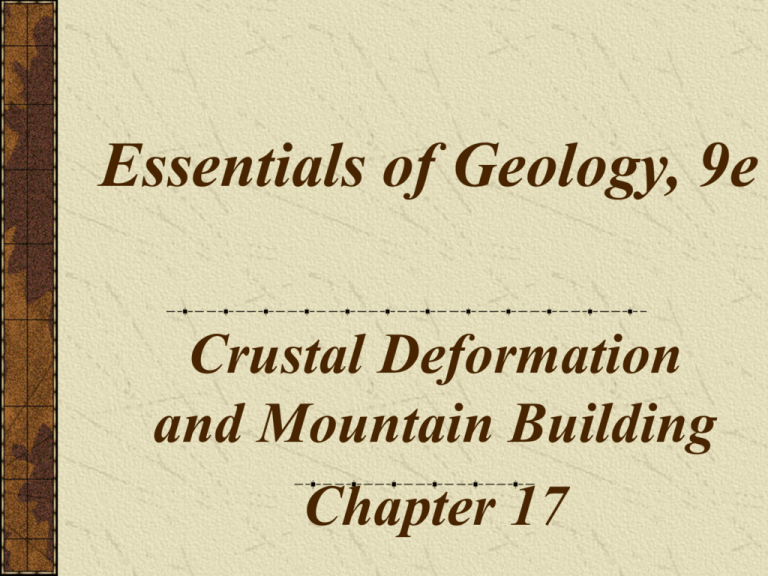
Essentials of Geology, 9e
Crustal Deformation
and Mountain Building
Chapter 17
Deformation
Deformation is a general term that refers
to all changes in the original form and/or
size of a rock body
Most crustal deformation occurs along
plate margins
Factors that influence the strength of a
rock
• Temperature and confining pressure
• Rock type
• Time
Folds
Rocks bent into a series of waves
Most folds result from compressional
forces which shorten and thicken the
crust
Types of folds
• Anticline – upfolded, or arched, rock layers
• Syncline – downfolded rock layers
Folds
Types of folds
• Anticlines and synclines can be
• Symmetrical - limbs are mirror images
• Asymmetrical - limbs are not mirror images
• Overturned - one limb is tilted beyond the
vertical
• Where folds die out they are said to be
plunging
A series of anticlines
and synclines
Figure 17.3
Plunging folds
Figure 17.4 A
Outcrop patterns of
plunging folds
Figure 17.4 B
Folds
Types of folds
• Other types of folds
• Dome
• Circular, or slightly elongated
• Upwarped displacement of rocks
• Oldest rocks in core
• Basin
• Circular, or slightly elongated
• Downwarped displacement of rocks
• Youngest rocks in core
The Black Hills of South Dakota
are a large dome
Figure 17.6
The bedrock geology of
the Michigan Basin
Figure 17.7
Faults
Faults are fractures (breaks) in rocks
along which appreciable displacement
has taken place
Types of faults
• Dip-slip fault
• Movement along the inclination (dip) of fault
plane
• Parts of a dip-slip fault
• Hanging wall – the rock above the fault
surface
• Footwall – the rock below the fault surface
Concept of hanging wall and
footwall along a fault
Copyright © 2006 Pearson Prentice Hall, Inc.
Faults
Types of faults
• Dip-slip fault
• Types of dip-slip faults
• Normal fault
• Hanging wall block moves down
• Associated with fault-block mountains
• Prevalent at spreading centers
• Caused by tensional forces
A normal fault
Figure 17.9 A
Fault block mountains produced
by normal faulting
Figure 17.10 bottom
Faults
Types of faults
• Dip-slip fault
• Types of dip-slip faults
• Reverse and thrust faults
• Hanging wall block moves up
• Caused by strong compressional stresses
• Reverse fault - dips greater than 45º
• Thrust fault - dips less than 45º
A reverse fault
Figure 17.9 B
A thrust fault
Figure 17.9 C
Faults
Types of faults
• Strike-slip faults
• Dominant displacement is horizontal and parallel
to the trend, or strike
• Transform fault
• Large strike-slip fault that cuts through the
lithosphere
• Often associated with plate boundaries
A strike-slip fault
Figure 17.9 D
Faults
Types of faults
• Joints
• Fractures along which no appreciable
displacement has occurred
• Most are formed when rocks in the outer-most
crust are deformed
Mountain belts
Orogenesis refers to processes that
collectively produce a mountain belt
Mountain building at convergent
boundaries
• Most mountain building occurs at
convergent plate boundaries
Mountain belts
Mountain building at convergent
boundaries
• Andean-type mountain building
• Oceanic-continental crust convergence
• e.g. Andes Mountains
• Types related to the overriding plate
• Passive margins
• Prior to the formation of a subduction
zone
• e.g. East Coast of North America
Mountain belts
Mountain building at convergent
boundaries
• Andean-type mountain building
• Types related to the overriding plate
• Active continental margins
• Subduction zone forms
• Deformation process begins
• Continental volcanic arc forms
• Accretionary wedge forms
• Examples of inactive Andean-type orogenic
belts include Sierra Nevada Range and
California's Coast Ranges
Orogenesis along an Andeantype subduction zone
Figure 17.14 A
Orogenesis along an Andeantype subduction zone
Figure 17.14 B
Orogenesis along an Andeantype subduction zone
Figure 17.14 C
Mountain belts
Mountain building at convergent
boundaries
• Continental collisions
• Where two plates with continental crust converge
• e.g., India and Eurasian plate collision
• Himalayan Mountains and the Tibetan
Plateau
Formation of the Himalayas
Figure 17.18
Mountain belts
Mountain building at convergent
boundaries
• Continental accretion
• Third mechanism of mountain building
• Small crustal fragments collide with and accrete
to continental margins
• Accreted crustal blocks are called terranes
• Occurred along the Pacific Coast
Modern day oceanic plateaus and
other submerged crustal fragments
Copyright © 2006 Pearson Prentice Hall, Inc.
Accreted terranes along the
western margin of North America
Figure 17.17
Mountain belts
Buoyancy and the principle of isostasy
• Evidence for crustal uplift includes wave-cut
platforms high above sea level
• Reasons for crustal uplift
• Not so easy to determine
• Isostasy
• Concept of a floating crust in gravitational
balance
• When weight is removed from the crust,
crustal uplifting occurs
• Process is called isostatic adjustment
The principle of isostasy
Figure 17.21
Erosion and resulting isostatic
adjustment of the crust
Copyright © 2006 Pearson Prentice Hall, Inc.
Figure 17.22 A
Erosion and resulting isostatic
adjustment of the crust
Copyright © 2006 Pearson Prentice Hall, Inc.
Figure 17.22 B
Erosion and resulting isostatic
adjustment of the crust
Copyright © 2006 Pearson Prentice Hall, Inc.
Figure 17.22 C
End of Chapter 17

